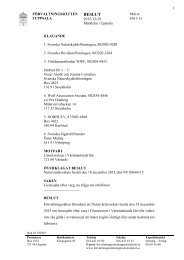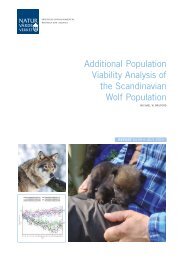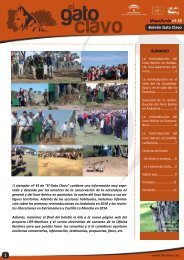1oC3Dbk
1oC3Dbk
1oC3Dbk
You also want an ePaper? Increase the reach of your titles
YUMPU automatically turns print PDFs into web optimized ePapers that Google loves.
Concern amphibian updates), as well as an ongoing review of<br />
62 assessments made locally for Cuban species, to ensure<br />
their compatibility with the global IUCN Red List and the<br />
participation of the Amphibian RLA.<br />
More IUCN Red List Assessments are prepared at<br />
national and, where appropriate, at regional scales<br />
(The ongoing development of national and regional<br />
Red Lists is catalysed)<br />
The IUCN Global Species Programme is working on regional<br />
assessment projects in Europe (involving GSP staff in the RLU,<br />
MBU, HQ and at the Brussels office) and in the Mediterranean<br />
(in collaboration with colleagues in the IUCN Centre for<br />
Mediterranean Cooperation in Malaga, Spain). Marine regional<br />
assessments are being conducted by the MBU and are<br />
reported on elsewhere.<br />
Europe: IUCN is currently producing European Red Lists for<br />
pollinators (2,000 bees), 300 priority medicinal plants, 1,200<br />
marine fishes and 520 birds (in collaboration with BirdLife). In<br />
the last two updates, 253 bee assessments were published<br />
(67 global) as well as 99 plant assessments (only three global).<br />
The focus on medicinal plants and pollinators underscores the<br />
value of The IUCN Red List in providing vital information on<br />
factors that inform the state of human well-being.<br />
Country factsheets showcasing the proportion of species that<br />
are threatened at the European level were developed for the 27<br />
EU Member States, based on the results of the European Red<br />
Lists completed so far. These factsheets were useful in<br />
promoting the use of the European Red List data and inform<br />
governments about their responsibility to take action to protect<br />
European threatened species.<br />
Mediterranean: Red List work in the Mediterranean is still<br />
very much in the initial phases of data compilation. Work is<br />
underway on a diverse range of taxonomic groups including:<br />
1,420 endemic plants (mostly monocots) which will be a<br />
significant contribution to The IUCN Red List once completed,<br />
222 dung beetles, 550 saproxylic beetles, and 164 anthozoans<br />
(not just corals but also sea anemones and other related<br />
species). A workshop involving 30 experts was held in Malaga<br />
in February 2013 to assess 468 butterflies. Work to finalize<br />
these assessments is underway. In addition, 500 species of<br />
freshwater fishes, molluscs and aquatic plants from the<br />
Eastern Mediterranean were assessed during a workshop held<br />
in Jordan in April, 2013.<br />
Reassessments of all the world’s amphibians, birds and<br />
mammals are underway to enable the next IUCN Red List Index<br />
data point to be calculated. A number of the reassessment and<br />
assessment projects are starting to use online discussion<br />
forums to help speed up the process and reduce the costs of<br />
holding expensive workshops; these forums are reported on<br />
elsewhere. Each update of The IUCN Red List includes these<br />
reassessments as they are completed, rather than being held<br />
back as in the past, to be published altogether at one time. The<br />
2013.1 update included many conifer reassessments,<br />
completing the second complete reassessment of all conifer<br />
species. The calculation of the Red List Index is underway and<br />
this will be published in 2014. Initial results show that there are<br />
significant declines in this taxonomic group with the proportion<br />
threatened having increased from 30 to 34% since 1998, partly<br />
as a result of the emergence of new diseases.<br />
The IUCN Red List is a scientifically rigorous tool for<br />
conservation (The IUCN Red List contains the necessary<br />
information to make it a reliable tool for informing<br />
biodiversity conservation)<br />
A number of the key documents supporting The IUCN Red List<br />
process have been revised or updated since September 2012.<br />
Many of these changes were required to ensure that all<br />
documents conformed with ‘The Rules of Procedure: IUCN<br />
Red List Assessment Process 2013–2016’, which were<br />
approved by the SSC Steering Committee. The IUCN Red List<br />
Categories and Criteria booklet was republished with revised<br />
Annexes (in all three official languages); the Guidelines for<br />
Using The IUCN Red List Categories version 10.1 was released<br />
in September 2013 (this key document is being translated into<br />
French and Spanish); the Guidelines for Application of IUCN<br />
Red List Criteria at Regional levels ver. 4 was finalized and<br />
published (in all three official languages); the ‘Documentation<br />
Standards and Consistency Checks for IUCN Red List<br />
Assessments and Species Accounts’ has been completely<br />
revised and updated and the draft of version 2.0 is available.<br />
All the key documents about The IUCN Red List processes<br />
and policies concerning use of the data, etc. are now<br />
available through a new Key Documents page on The IUCN<br />
Red List website.<br />
Yvonne Sadovy, Co-Chair of the IUCN SSC Grouper and Wrasse Specialist<br />
Group, studying the Near Threatened Camouflage Grouper (Epinephelus<br />
polyphekadion) in a spawning aggregation. © Eric Clua.<br />
Marine Biodiversity Unit: Four regional workshops were<br />
completed or will be completed in 2013, including fishes of the<br />
Caribbean, Eastern Central Atlantic, European, and Persian<br />
Gulf, to assess approximately 1,620 species. The Caribbean<br />
and Eastern Central Atlantic initiatives are nearly complete: out<br />
of a combined total of over 2,600 species, less than 500<br />
remain unevaluated. The European and Persian Gulf initiatives<br />
represent geographic expansions of the MBU in 2013.<br />
IUCN Red List Index (Wide use of the Red List Index<br />
(RLI) as an indicator for monitoring trends in the status<br />
of species groups is developed and promoted)<br />
12 IUCN species Annual Report 2013






